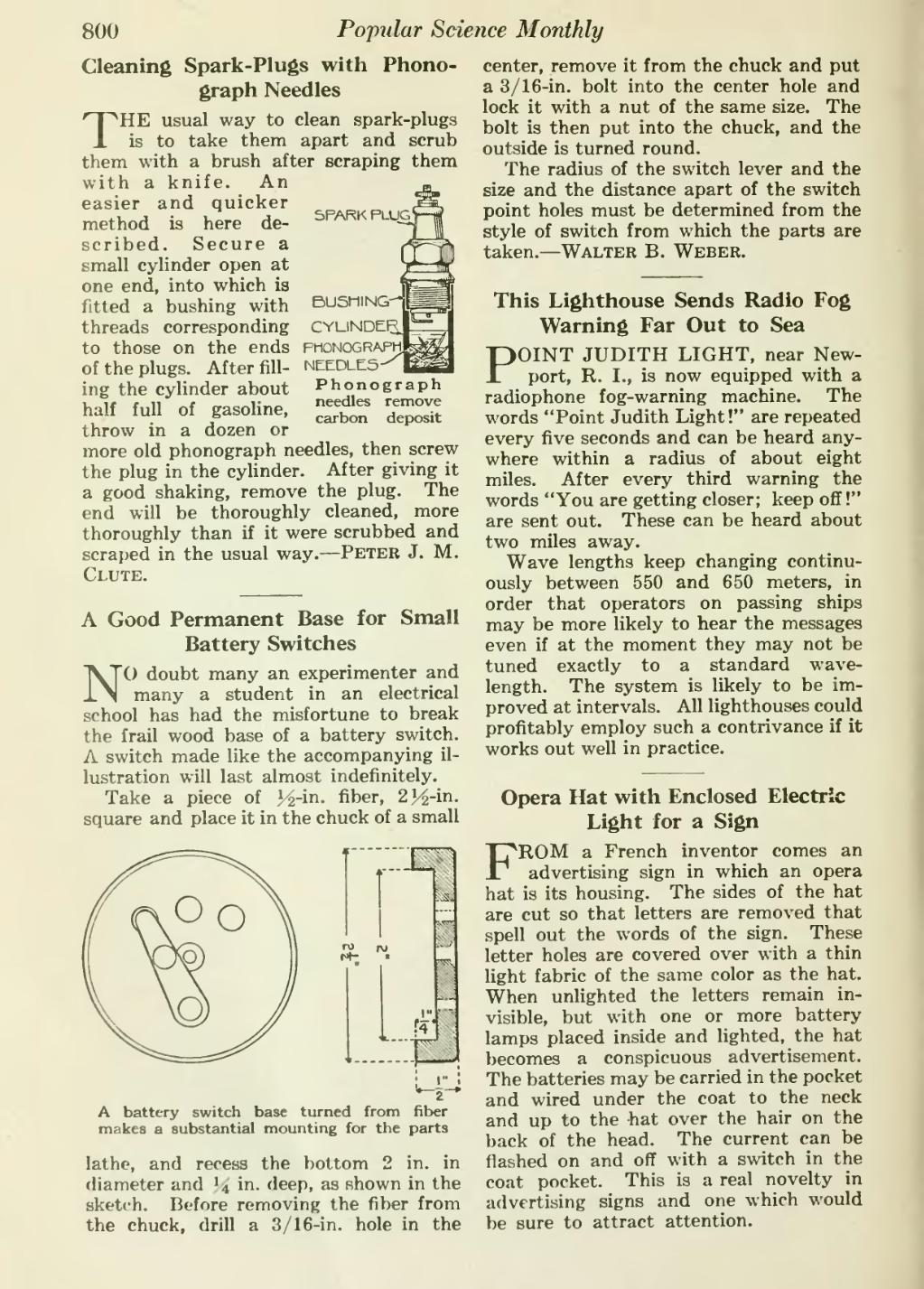800
��Popular Science Monthly
��Cleaning Spark-Plugs with Phono- graph Needles
THE usual way to clean spark-plugs is to take them apart and scrub them with a brush after scraping them with a knife. An easier and quicker method is here de- scribed. Secure a small cylinder open at one end, into which is fitted a bushing with threads corresponding to those on the ends pmonographI of the plugs. After fill- NEEDLE5- ing the cylinder about Phonograph half full o£ gasoline, J«*n depoTi? throw in a dozen or more old phonograph needles, then screw the plug in the cylinder. After giving it a good shaking, remove the plug. The end will be thoroughly cleaned, more thoroughly than if it were scrubbed and scraped in the usual way. — Peter J. M. Clute.
��SPARK PLUG
��DU5niNG- CYLINDER
���A Good Permanent Base for Small Battery Switches
NO doubt many an experimenter and many a student in an electrical school has had the misfortune to break the frail wood base of a battery switch. A switch made like the accompanying il- lustration will last almost indefinitely.
Take a piece of J^-in. fiber, 2J^-in. square and place it in the chuck of a small
����A battery switch base turned from fiber makes a substantial mounting for the parts
lathe, and recess the bottom 2 in. in diameter and % in. deep, as shown in the sketch. Before removing the fiber from the chuck, drill a 3/16-in. hole in the
��center, remove it from the chuck and put a 3/16-in. bolt into the center hole and lock it with a nut of the same size. The bolt is then put into the chuck, and the outside is turned round.
The radius of the switch lever and the size and the distance apart of the switch point holes must be determined from the style of switch from which the parts are taken. — Walter B. Weber.
��This Lighthouse Sends Radio Fog Warning Far Out to Sea
POINT JUDITH LIGHT, near New- port, R. I., is now equipped with a radiophone fog-warning machine. The words "Point Judith Light!" are repeated every five seconds and can be heard any- where within a radius of about eight miles. After every third warning the words "You are getting closer; keep off!" are sent out. These can be heard about two miles away.
Wave lengths keep changing continu- ously between 550 and 650 meters, in order that operators on passing ships may be more likely to hear the messages even if at the moment they may not be tuned exactly to a standard wave- length. The system is likely to be im- proved at intervals. All lighthouses could profitably employ such a contrivance if it works out well in practice.
��Opera Hat with Enclosed Electric Light for a Sign
FROM a French inventor comes an advertising sign in which an opera hat is its housing. The sides of the hat are cut so that letters are removed that spell out the words of the sign. These letter holes are covered over with a thin light fabric of the same color as the hat. When unlighted the letters remain in- visible, but with one or more battery lamps placed inside and lighted, the hat becomes a conspicuous advertisement. The batteries may be carried in the pocket and wired under the coat to the neck and up to the hat over the hair on the back of the head. The current can be flashed on and off with a switch in the coat pocket. This is a real novelty in advertising signs and one which would be sure to attract attention.
�� �
